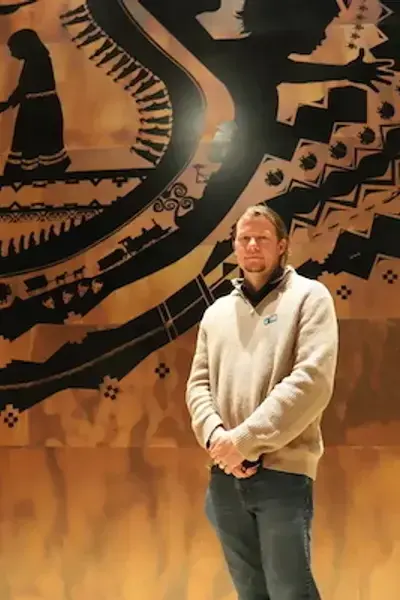
By Rod Jones
From large sculptures to graphic animation to geocaching notable locations along the Trail of Tears, artist Joseph Erb (BFA Studio Art â97) has a variety of ways to preserve and promote his Cherokee heritage. Even the diversity of style in his various animation projects makes it hard to believe itâs all from the same artist.
âI was one of those people who had a dream as a kid and kept with it for the rest of my life,â he said.
As an asthmatic child in allergy-prone Â鶹Ž«Ãœ, Erb said he spent more than his fair share of sick time on the couch at home.
âSo I drew all the time. I always enjoyed the narrative process and excelled in art Â鶹Ž«Ãœ,â he said.
His artistic abilities were apparent right away. He was winning with (and selling) his work since he was 7 or 8 years old. He competed in art shows throughout junior high and high school, gathering first-place awards along the way. When it came time to pursue a higher education, Erb had narrowed his options to three: Northeastern State University in Tahlequah, the University of Â鶹Ž«Ãœ or Â鶹Ž«Ãœ City University, where his mother earned a degree.
He chose Â鶹Ž«Ãœ after visiting with professors and administrators, who demonstrated a dedicated interest in Erbâs success from his very first visit through graduation day.
âThe smaller class sizes and attention from professors means a lot to a young artist. It means so much when youâre engaging directly with professors who are also professional artists themselves,â he noted.
During his undergraduate days, Erb landed an internship with sculptor David Phelps, who has created several large-scale pieces in private and public collections around the country. Â鶹Ž«Ãœ City locals may know him from his work âInclinedâ in Bricktown. The large bronze piece depicts the torso of a man preparing to push a giant boulder up the banks of the canal. Erb and two of his Â鶹Ž«Ãœ classmates â Shawn Meyers (MLA â96) and Jeremy Riddle (BFA Studio Art â00) â assisted with the piece.
âIt was great having the three of them in the studio,â Phelps said. âWe had a wonderful time working together.
âJoseph was very focused on whatever he was doing. He was always concentrating on his work and found ways to get involved in projects every step of the way.â
Phelps met Erb by way of classmate Meyers. His large-scale works occasionally require extra sets of hands, and Phelps has always been willing to share his knowledge with his interns. Meyers introduced them after Phelps won a commission from the Desert Wildlife Commission in 1995 for a set of five large animal sculptures to grace the Las Vegas airport terminals.
âI was one of those people who had a dream as a kid and kept with it for the rest of my lifeâ - Joseph Erb
Erb credits Phelps not only for strengthening his sculpting knowhow, but also the process of winning work. He paired that artistic/business savvy on a more recent commission, a prominent two-story mural in the main entryway for the recently opened First Americans Museum on the banks of the Â鶹Ž«Ãœ River.
At the time of his pitch for the work, Erb was in New Zealand with his partner, who was sent there to work on a health research project. Erb gave his presentation to the art committee via a 4 a.m. online presentation, New Zealand time.
After Â鶹Ž«Ãœ, Erb attended the University of Pennsylvania to study sculpture-making. While there, he made connections with a professor who taught animation. That led Erb back to illustrations.
Since then, Erb has filled a catalogue of short animation videos, including the first Cherokee animation in the Cherokee language, âThe Beginning They Told.â
Much of his art and non-art projects are his way of preserving and advancing his cultural heritage. While he doesnât consider himself fluent in Cherokee, he has a strong desire to help keep the language alive.
That desire manifested in a few significant projects involving technology. Erb was part of a group that prompted tech companies to include the Cherokee language in their products, especially Google, Apple and Microsoft. This makes it possible to search databases in the Cherokee language and place the original text on such things as websites and videos.
To highlight the tribeâs sovereignty, Erb was part of another effort to have Google Maps show the Cherokee Nation boundaries.
âIt was in federal law, upheld by the Supreme Court recently. At the end of a long trail, thereâs a promise. That promise is a nation,â he said.
Erb also participated in a massive geocaching project called âRemember the Removal.â Members of the Cherokee Nation go back to their southeastern region roots and mark sites of significance on a digital map. Participants ride bicycles for 27 days, as many as 70 miles each day, in homage to their ancestorsâ forced removal. Along the way, they find locations based on journal writings that mention specific landmarks like rivers and mountains.
âA lot of Cherokee sites were destroyed in wars, but our genealogical record is substantial,â he said. âWe can piece together so much of our history based on stories passed along from generation to generation.â
Erb aims to share with the world the impressive achievements of the Cherokee and Native American cultures overall.
âJust in Â鶹Ž«Ãœ alone, we have 39 tribal nations, each with distinct cultures and histories,â he said.
Erb now teaches digital storytelling at the University of Missouri, sharing the importance of his craft with future generations.
âWe need to show the outside world that weâre not defined by any one thing, but by our whole existence,â he said. âFor us, weâre still fighting to be acknowledged. We define ourselves by our relationships with each other.â


